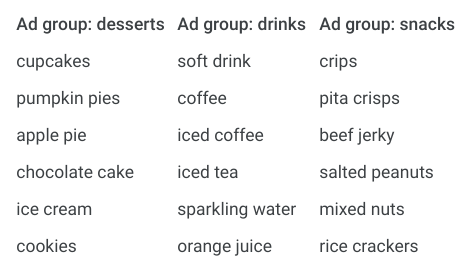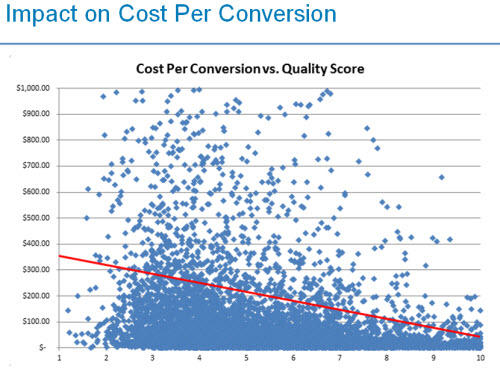It’s the single most common topic on search engine marketing forums and discussion groups, and for good reason. The single keyword per ad group (SKAG) campaign structure promises to maximize the performance of your Google and Bing search engine marketing campaigns. As opposed to traditional campaign structures, SKAG gives you complete control over each individual keyword variant, but end up being much more complex to set up. Whether it’s the right strategy for you depends on a number of considerations, but in most cases switching to a SKAG structure for your SEM campaigns will result in lowered cost-per-click (CPC), higher click-through (CTR), and as a result higher Quality Scores (QS) for your keywords.
Already sold? Then jump right into our guide for setting up your first SKAG campaign, complete with template!
What are Single Keyword per Ad Group (SKAG) Campaigns?

Example of Ad Group Structure from Google
Traditional PPC search engine marketing campaigns will typically have multiple keywords pooled into ad groups, to which your ad copy is attached. As you can see, ad groups will typically contain multiple keywords that are potentially quite different, and only sharing a common theme. In the examples provided below, there are three ad groups. This means there will also be three sets of ad copy. Since you are combining different terms like “cupcakes”, “apple pie” and “cookies”, the ad copy you create will have to be broad enough to properly cover all of them. While dynamic keyword insertion can help improve the relevance of your ad copy to your keywords, it will never be as precise as custom copy, designed for each keyword.
Single keyword per Ad Group campaigns are self explanatory. They modify the traditional structure of SEM campaigns by applying a dedicated ad group to each keyword.
What are the Benefits of SKAG Campaigns?
The precise control that SKAG campaigns offer PPC professionals is undeniable, but unless you properly take advantage of it, you won’t be seeing any benefits. Ongoing success and continuing improvement requires you to not just follow best practices, but maintain vigilance over your account. That being said, the benefits of using this campaign structure are well documented. In particular, you can expect to see improved:
- Quality Score (QS)
- Click-through-Rate (CTR)
- Cost-per-Click (CPC)
- Cost-per-Conversion/Lead (CPL)

Cost per Conversion decreases as QS increases: courtesy WordStream
Quality Score
These in turn lead to improved metrics across the paid search channel. The core benefit of using the SKAG structure is an improvement in Quality Score. This is a critically important metric for Google Ads. Your Quality Score is a rating from 1 to 10, based on things like expected click-through rate (CTR), your landing page experience, and the relevance of your ads. SKAG in particular focus on improving the relevance of your ads, but also allow you to give each individual keyword variant its own landing page as well, further boosting your QS.
When you first set up Google AdWords, Google actually instructs you to set up your account wrong.
Tough words, but in most cases he is right.
Further Benefits of SKAG Campaigns
You simply won’t be able to get the same performance from traditionally structured campaigns. That’s not to say you won’t be successful or have a negative ROI or ROAS. It just means it’s likely there’s room for further improvement. SKAG campaigns are also excellent at covering keyword gaps that competitors using other structures, or with poor keyword research, might have missed.
What do SKAG Campaigns Look Like?
The major difference between SKAG and traditional campaigns will be the number of ad groups. Your naming conventions and campaign structures may also change, depending on how much additional precision you have built in.
Additional Modifications for Further Precision
There are additional considerations in play when building your campaigns besides just your keywords. The SKAG campaign structure is typically further expanded in various ways, allowing for segmentation of things like:
- Match Type
- Device Type
- Geographical Locations
- Demographics
- Any Other Relevant Segments
What does this mean? Let’s say we’re trying to show results for the keyword cupcakes. The traditional ad group structure would include all match types, which are exact, phrase and broad (bmm). A modified SKAG would segment the cupcake keyword into three different variants for each match type: [cupcakes], “cupcakes” and +cupcakes. Note that we never use broad on its own, but only as broad match modifier terms.
Devices should be segmented, since CPCs as well as conversion rates can vary significantly. It depends on the individual industry, but mobile, tablet and desktop users typically behave differently, and as a result, bids are different. You may opt to simplify your SKAG structure by merging device types, and using bid adjustments, but that’s using an axe instead of a scalpel. Not really in line with the underlying goal of complete control we’re trying to accomplish.
Depending on your scale and budget, further segmentation can be implemented. This can result in you having cupcake as an exact match keyword, on mobile, and within Central London. It would have its own dedicated metrics and ad copy, giving you complete visibility to monitor and manage performance.

SKAG campaigns aren’t for everyone
Limitations and When You Shouldn’t Use SKAG Campaigns
Yes, SKAG campaigns are powerful tools that help you maximize the performance of your search engine marketing campaigns while keeping you in maximum control. They’re not for everyone, however. Here are some points to consider, including the following.
Small Scale or Budget
SKAG campaigns are by design incredibly granular. As a result, if you don’t have sufficient scale or budget, you may not be getting enough data to provide actionable intelligence. One keyword becomes three when split by device, and the volume scales rapidly with additional segmentation. Smaller-scale campaigns can use SKAG, but must limit their total keyword counts, or accept that it may take longer to gather enough data.
Decreased Match Type Overlap
Google has been diluting the accuracy of their match types for years, and this poses a potentially big problem for our SKAG campaigns. After all, performance varies by match type, and not being able to use it as a metric can have a negative impact on your overall control and ability to give you meaningful data for your strategy.
To combat this trend, we apply additional limits on all of our keywords using their match types as negative keywords. We stack the negatives from broad to exact. For example:
+Cupcakes as a BMM keyword would have “Cupcakes” and [Cupcakes] negative matched within the ad group
“Cupcakes” as a phrase keyword would have [Cupcakes] negative matched within the ad group
[Cupcakes] as the exact phrase remains as is
The idea here is to negate the dilution effect by further reinforcing the split between match types.
Complexity and Management
Creating a professionally-built SKAG campaign that follows modern best-practices can be a complex undertaking. Not only is there an increased time investment during initial build, but management also requires more vigilance. Google continues to expand their search product offering, by introducing automation and artificial intelligence. As the quality of these improve, the justification for SKAG builds may fall.
Should You Use SKAG Builds For Your SEM Campaigns?
Are you a digital marketing agency or search professional? Then yes, in most cases you probably should. We have the background and the expertise to implement and manage these campaigns, and the benefits to client performance are hard to ignore. We use SKAG by default when a client has a budget of £5,000 per month or more, and in most cases for smaller ones as well. The consideration here for you as a freelancer or agency is whether or not the time investment will be worth the performance gain.
For smaller businesses or people just wanting to get started with Google or Bing Ads, then it may be overkill. It may take you a long time to gather enough data to start making meaningful changes. Instead, a smaller account would be better advised focusing on building a comprehensive negative keyword list and vigilantly watching search queries to remove non-performing keywords and phrases, and identify additional long-tail keywords to add. Once you get familiar with SEM and the consoles you are using, you can start considering whether a SKAG build makes sense.
Want to get started yourself? Continue onto our step-by-step guide to building SKAG campaigns and get to testing!



